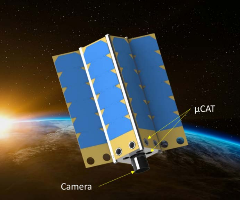| Spacecraft | GW-Sat (GWSat) |
|---|---|
| Spacecraft type | CubeSat |
| Units or mass | 3U |
| Status | cancelled |
| Organisation | George Washington University |
| Institution | University |
| Entity type | Academic / Education |
| Nation | US |
| Partners | Costa Rica Institute of Technology (ITCR) |
| Oneliner |
Test micro-cathode arc thruster (μCAT) that uses a solid metallic propellant, such as titanium. |
| Description |
Test a micro-propulsion device called the micro-cathode arc thruster (μCAT) that uses a solid metallic propellant, such as titanium, to produce small controllable impulse bits as the CubeSat’s 3-axis stabilization system. Engineering students work on this project alongside their classroom studies. The radio art experiment will be to have the satellite radio act as a digipeater that can be used by Amateurs. The plasma arc thrusters are an experiment designed by mechanical engineering and physics students at George Washington University. The attitude control software is developed by physics, engineering, and computer science students. A camera will be onboard that will take pictures of the earth and validate attitude determination and control. Our mission is purely educational and student led. It helps advance the radio art by educating students about and encouraging interest in radio. The micro thruster knowledge gained may contribute to amateur satellites by supporting longer lifetimes in LEO. |
| Notes | |
| Sources | [1] [2] [3] [4] |
| Photo sources | [1] |
| Keywords | Propulsion |
Last modified: 2024-09-02

